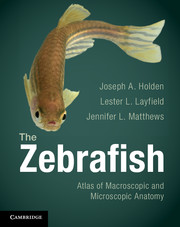Book contents
- Frontmatter
- Contents
- Preface
- Acknowledgments
- Chapter 1 Introduction
- Chapter 2 Cross section and longitudinal section atlas
- Chapter 3 Integument (skin)
- Chapter 4 Digestive system
- Chapter 5 Respiratory system
- Chapter 6 Circulatory system
- Chapter 7 Liver and gallbladder
- Chapter 8 Pancreas
- Chapter 9 Endocrine organs
- Chapter 10 Kidney
- Chapter 11 Reproductive system
- Chapter 12 Sensory systems
- Chapter 13 Central nervous system
- Chapter 14 Miscellaneous structures
- Chapter 15 Musculoskeletal system
- Index
- References
Chapter 14 - Miscellaneous structures
Published online by Cambridge University Press: 05 February 2013
- Frontmatter
- Contents
- Preface
- Acknowledgments
- Chapter 1 Introduction
- Chapter 2 Cross section and longitudinal section atlas
- Chapter 3 Integument (skin)
- Chapter 4 Digestive system
- Chapter 5 Respiratory system
- Chapter 6 Circulatory system
- Chapter 7 Liver and gallbladder
- Chapter 8 Pancreas
- Chapter 9 Endocrine organs
- Chapter 10 Kidney
- Chapter 11 Reproductive system
- Chapter 12 Sensory systems
- Chapter 13 Central nervous system
- Chapter 14 Miscellaneous structures
- Chapter 15 Musculoskeletal system
- Index
- References
Summary
Spleen
In fishes, hematopoiesis occurs within both the spleen and kidney. The spleen lies between the intestinal bulb and the liver (Figure 14.1). On gross and microscopic exam, the spleen appears to be composed predominantly of nucleated red blood cells with fewer numbers of lymphocytes. White and red pulp are not well demarcated in most histologic sections of fish splenic tissue (Figure 14.2). Most of the spleen is composed of red pulp formed by sinusoids containing nucleated red blood cells. The white pulp is composed of lymphocytes aggregating around vessels.
Thymus
The thymus appears as a lymphoid organ seen in the gill cavity just ventral to the ear (Figure 14.3). The thymus lies in the same plane as the heart and is characterized by a high density of small cells with large nuclei (Figure 14.4). This pattern results in dark staining of the organ. The zebrafish thymus lies within the same position and has the same appearance as the thymus of other teleosts,. The epithelium associated with the thymus is continuous with the pharyngeal epithelium. At high magnification, thymocytes appear as groups of packed cells (epithelial cells) between lymphoid cells (Figure 14.4),.
- Type
- Chapter
- Information
- The ZebrafishAtlas of Macroscopic and Microscopic Anatomy, pp. 130 - 133Publisher: Cambridge University PressPrint publication year: 2013



